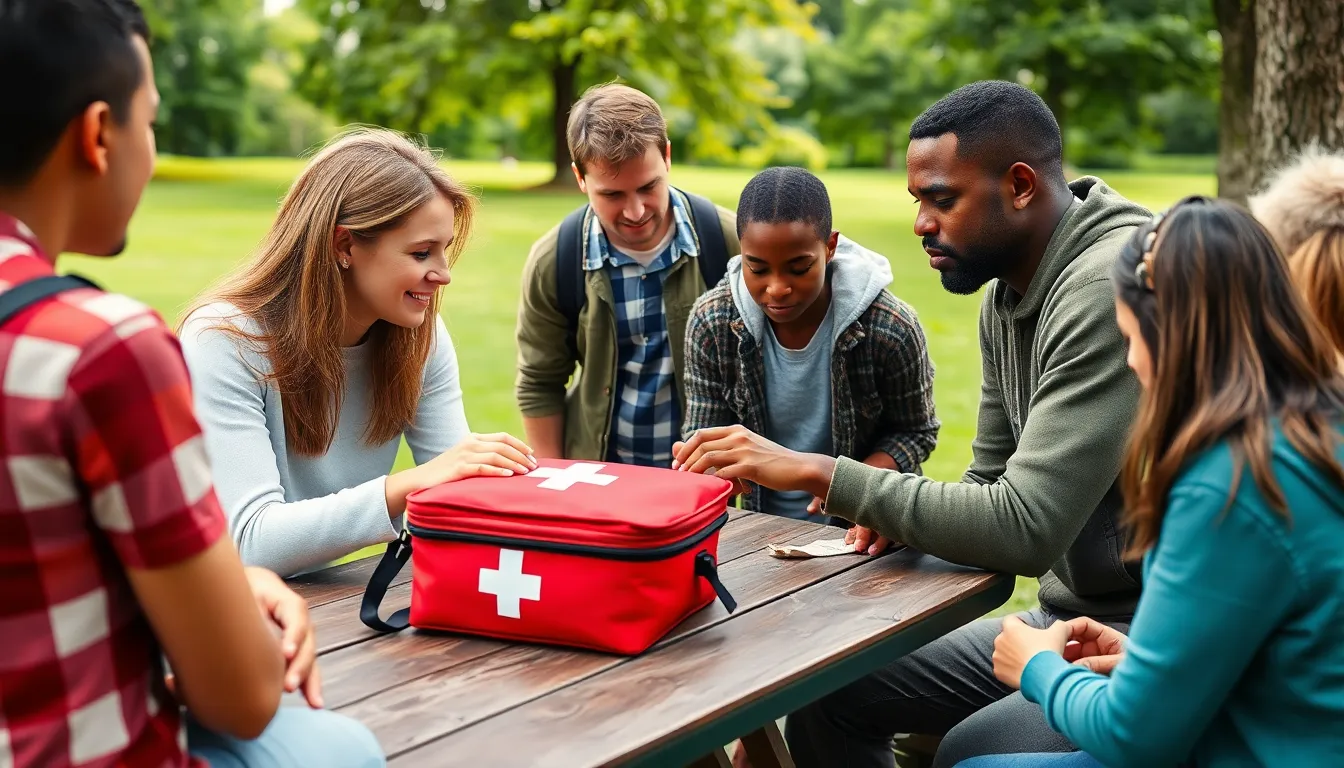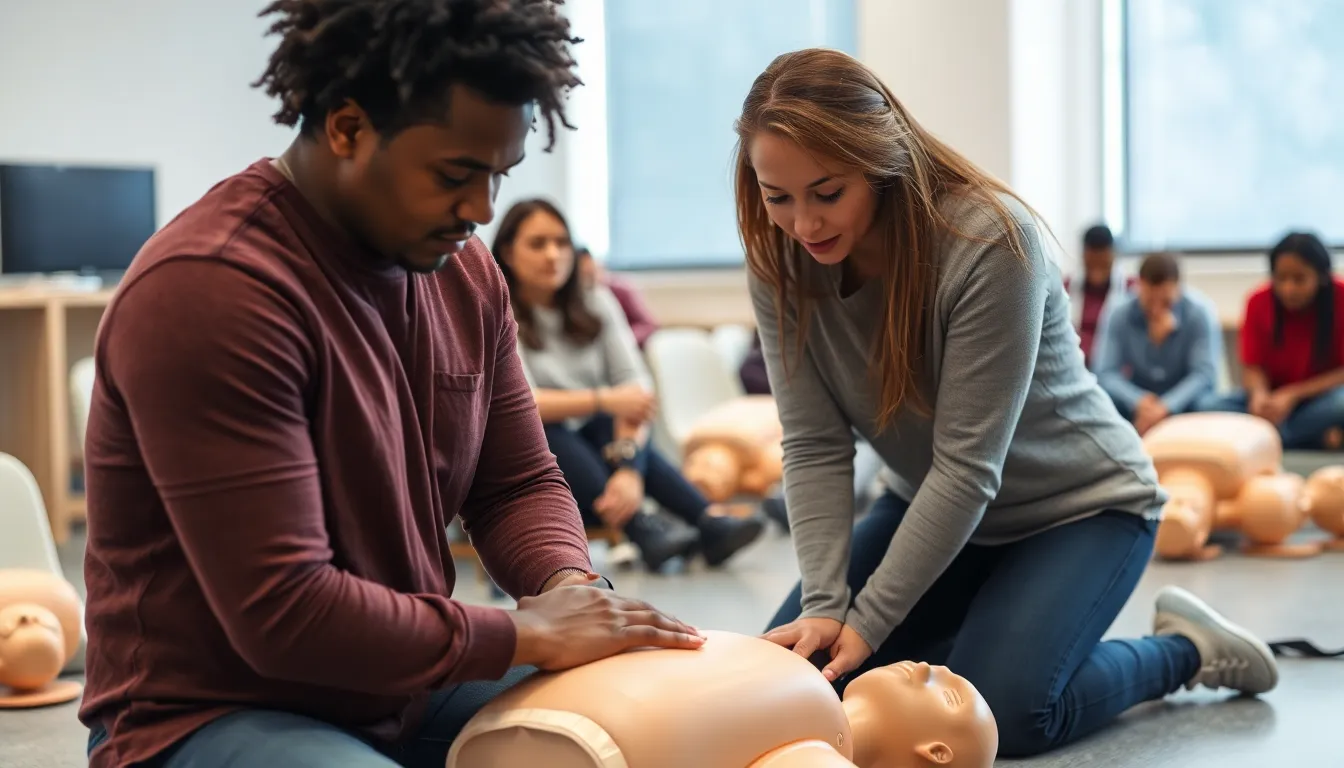When life throws a curveball—be it a paper cut or a full-blown kitchen disaster—knowing the basics of first aid can turn a potential crisis into a mere hiccup. Imagine being the hero in a sitcom episode where the main character gets a little too enthusiastic with the hot sauce. With the right first aid knowledge, they won’t need to call for backup; they’ll just need a cool compress and some TLC.
Table of Contents
ToggleUnderstanding First Aid Basics
First aid serves as immediate assistance provided to an injured or ill person until professional medical help arrives. Recognizing the importance of these initial actions can be crucial in various situations, encompassing everything from minor cuts to serious medical emergencies.
Definition of First Aid
First aid refers to the basic care offered to someone experiencing a medical emergency. This care includes assessing the situation, stabilizing the individual’s condition, and preventing further harm. Techniques range from applying pressure to a bleeding wound to performing CPR on an unresponsive individual. Resources such as the American Red Cross offer comprehensive courses outlining essential first aid skills.
Importance of First Aid
Knowing first aid can significantly impact health outcomes. Rapid response during emergencies often leads to better recovery rates. In life-threatening situations, timely interventions can save lives. Individuals trained in first aid can manage a variety of scenarios, from treating burns to addressing choking incidents. Additionally, having these skills fosters confidence and empowers people to assist others during crises. Statistically, effective first aid measures decrease the severity of injuries in 40% of cases.
Common First Aid Techniques
Understanding common first aid techniques is vital for responding effectively in emergencies. Knowledge of these skills can make a significant difference in the outcome of various situations.
CPR (Cardiopulmonary Resuscitation)
CPR is essential in cases of cardiac arrest. When someone stops breathing or has no heartbeat, immediate action increases their chances of survival. The process involves chest compressions and rescue breaths. Compressions should be delivered at a rate of 100 to 120 per minute, maintaining a depth of about two inches. Rescue breaths follow a compression cycle, typically delivered at a ratio of 30 compressions to two breaths. Participants in CPR training, like those offered by the American Red Cross, learn the correct techniques to perform these life-saving procedures effectively.
Choking Relief Techniques
Choking can quickly become life-threatening. Abdominal thrusts, also known as the Heimlich maneuver, provide an effective way to relieve a blocked airway. For adults and children over one year, grasp the person from behind and place a fist just above their navel. Compress inward and upward sharply. Administer five thrusts, alternating with five back blows if necessary. In infants under one year, use back blows followed by chest thrusts. Educating oneself on these techniques can help reduce the risk of choking fatalities significantly.
Wound Care and Bandaging
Proper wound care is critical for preventing infection and promoting healing. Start by cleaning the wound gently with soap and water. Pat it dry with a clean cloth or gauze. Next, apply an antiseptic solution to kill bacteria. Cover the wound with a sterile bandage, ensuring it remains clean and dry. Replace the bandage regularly, especially if it becomes wet or dirty. Understanding these steps can significantly improve recovery rates, minimizing complications from wounds.
First Aid Supplies and Kits
Having the right supplies can greatly enhance first aid response effectiveness. A well-stocked first aid kit ensures readiness for various emergencies.
Essential Items for a First Aid Kit
Include adhesive bandages in various sizes for small cuts. Ensure gauze pads and adhesive tape are available for larger wounds. Stock antiseptic wipes to clean injuries and prevent infection. Adding a pair of scissors helps in cutting tape and gauze easily. Incorporate tweezers for removing splinters or debris. Pain relievers like ibuprofen or acetaminophen can manage discomfort effectively. Consider including a CPR face shield to perform rescue breaths safely. Lastly, a first aid manual provides essential guidance during emergencies.
Customizing Your First Aid Kit for Specific Needs
Tailor the first aid kit based on individual or family needs. For outdoor enthusiasts, add insect repellent and sunscreen to the kit. Parents should consider including pediatric medications for children. Travelers might benefit from anti-diarrheal medications and motion sickness remedies. Consider special needs, such as including EpiPens for those with severe allergies. For pet owners, a separate kit with pet-safe supplies can address animal-specific injuries. Customizing ensures that everyone receives appropriate care in an emergency.
First Aid for Specific Situations
Effective first aid techniques vary based on the situation. Recognizing the correct response for each specific injury type ensures better outcomes.
First Aid for Burns
Burns require immediate attention. Begin by cooling the affected area under running water for at least 10 minutes. Applying a clean, non-stick dressing helps protect the burn. Avoid using ice, which can further damage the tissue. For serious burns, seek medical help promptly. Recognizing burns by degrees—first-degree being minor redness and third-degree presenting as charred skin—guides treatment decisions. Treat first-degree burns with aloe vera or soothing ointment, while third-degree burns necessitate professional evaluation.
First Aid for Cuts and Scrapes
Promptly treating cuts and scrapes minimizes infection risk. Begin by rinsing the wound gently under clean water to remove debris. Applying antiseptic and a sterile bandage creates a protective barrier. When bleeding occurs, apply gentle pressure with a clean cloth until it stops. Continuous bleeding for over 10 minutes requires medical assistance. Monitor for signs of infection, including increased redness, swelling, or discharge. Knowing to change bandages regularly ensures optimal healing.
First Aid for Sprains and Strains
Sprains and strains respond well to the R.I.C.E. method—rest, ice, compression, and elevation. Initially rest the injured area to prevent further damage. Applying ice wrapped in a cloth reduces swelling. Compression with an elastic bandage helps stabilize the injury. Elevating the limb above heart level decreases swelling, allowing better blood circulation. Seek medical advice if severe pain or inability to move the joint occurs. Understanding recovery time varies based on injury severity aids in management decisions.
Conclusion
Mastering first aid basics is a vital skill that can make a significant difference in emergency situations. By understanding essential techniques like CPR and wound care individuals can respond confidently and effectively when it matters most.
Having a well-stocked and customized first aid kit ensures readiness for various scenarios, empowering people to provide immediate assistance. The knowledge of first aid not only enhances personal safety but also fosters a sense of community responsibility.
Being prepared can lead to better health outcomes and potentially save lives. Investing time in learning these skills is a step toward becoming a proactive member of society ready to help others in need.





